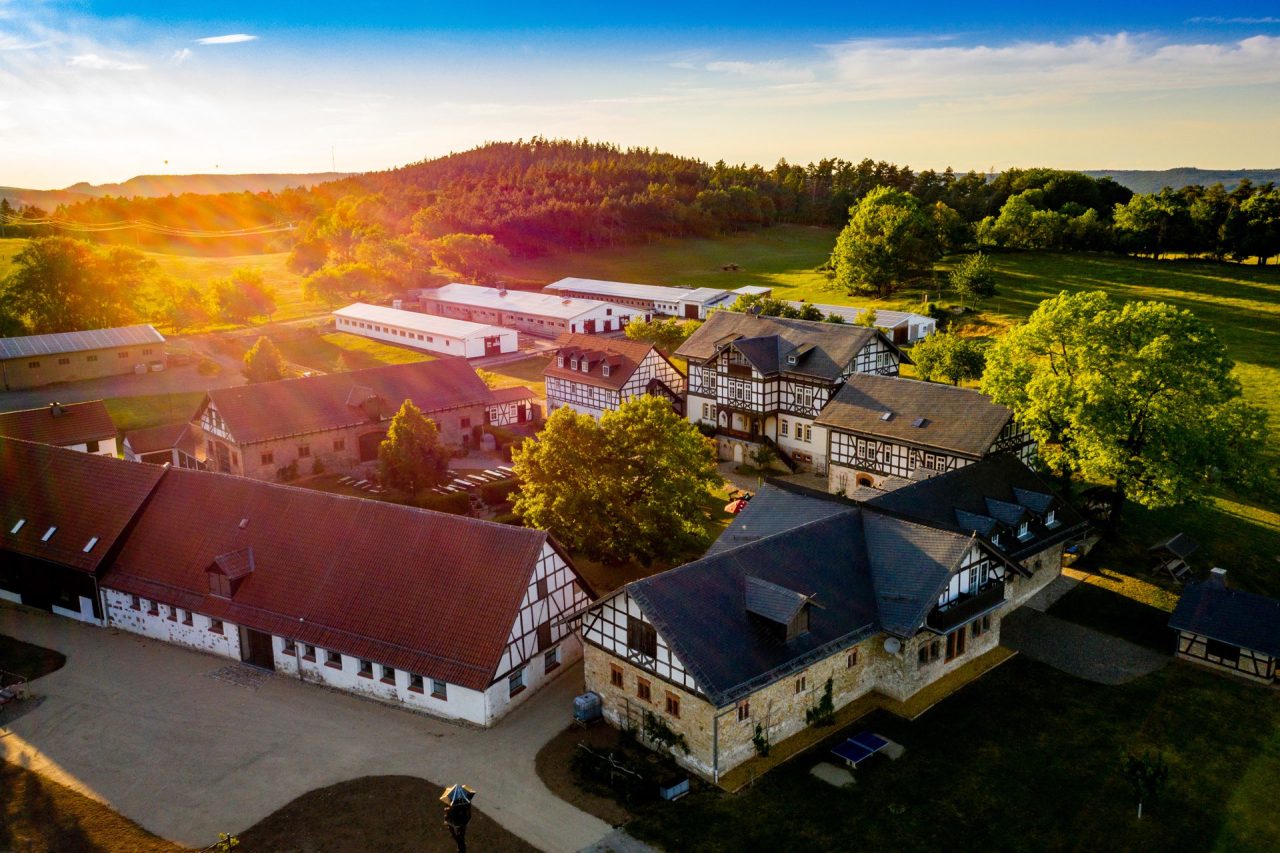
Mentioned for the first time in 1334
The history of the Groschwitz domain
How it all began….
| Groschwitz is first mentioned in a letter from the monastery of Stadtilm in 1334, where it is called “in Villa Groyzwitz” inhabited by 3 interest debtors of the Ilm monastery. Around 1381 the name of the village changed to “Kroswitz”, and in 1411 it was called “Kraschzwicz”. Judging by the spelling, it is a Slavic settlement where, as confirmed by finds of pottery and iron tools from the 13th century, farmers still lived at that time. The inheritance book of Bad Blankenburg from 1512 mentioned 11 families in Groschwitz, but this does not prove the existence of the village, it is rather assumed that the people lived in neighbouring villages. Instead, it is assumed that the farming village had already been abandoned towards the end of the 15th century and a foreland with a sheep farm had been established in its place. If one looks at the interest, rents and other levies that had to be paid to the Blankenburg office, it is noticeable that it was basically only oats or money, proof that in earlier times sheep farming was intensively practised up there, but the cultivation of demanding crops was not possible. In 1612, 3 bulls, 2 riding oxen, 7 cows, 4 calves, 195 mutton, 166 old sheep, 119 yearlings, 10 pigs and 15 chickens were kept in the outpost. It was not until 1768/74 that Groschwitz was mentioned again, as a manorial chamber estate in the office of Rudolstadt, with a rent of 367 Rthlr. In 1787 Groschwitz consisted of only one dwelling house and had 8 inhabitants. The Handbuch, 27. chap., “untergegangene schwarzburgische Dörfer” says: “was previously a village, now there is only a chamber estate there.” Until 1828 Groschwitz belonged to the office of Bad Blankenburg. With the separation of the offices on 01.01.1829, it was incorporated with Lichtstedt into the Rudolstadt office. The following note dates from 1863: “Groschwitz is a princely estate. A quarter of an hour north of Lichtstedt, 1416 feet (=400m) above sea level, situated on a bare shell limestone hill, the highest residence in the district and therefore visible from afar. The residential buildings and stables are mostly new and built in station style. The estate comprises 259 acres (=85ha) of field, 8 acres (=2.6ha) of meadow and 69 acres (=17ha) of pasture. Livestock: 4 horses, 2 oxen, 1 bull, 12 cows, 3 young cattle, 375 sheep, 12 pigs and 26 geese. Most of the field work is done by inmates of the state workhouse. Formerly a village, its inhabitants moved to neighbouring villages after a fire. Another report from 1881 states that the landowner is the princely chamber estate and that this domain covers 88 hectares. |
| The head of the estate is the domain tenant Rudolstadt-Saalfeld and the estate district belongs to the district court district of Rudolstadt. It remained like this until the end of the First World War. After 1918, the princely property becomes state property. Groschwitz is now owned by the state of Thuringia. New tenants moved into the estate and managed the farm until 1949. In 1922 the estate had 29 hectares of land, of which 24 hectares were arable land, 3 hectares were meadow and 2 hectares were grassland. Large livestock included 3 horses, 12 head of cattle and 5 pigs. The smaller size of 29 ha was probably due to the fact that large parts of the Groschwitz field had become parade ground for the Rudolstadt garrison. These parts were successively recultivated and when the land was handed over to the Association of Nationally Owned Estates in 1949, the agricultural area was 61.82 ha. By 1953 it had been expanded to 87.89 ha. The area ratios are subject to constant fluctuations due to the takeover and transfer of parcels. We can speak of an average size of about 80 ha in the last 150 years. The soil consists of various types of shell limestone. Soil tests showed that about 93% of the total area of arable land is heavy soil, so that the field work required an increased amount of labour. An advantage for the cultivation of the fields in Groschwitz is the fact that they are mostly located at a distance of up to about 500 m from the estate. The relatively harsh climate – the annual average is about 6.7 C° – is well suited for raising cattle and pigs. Thus, intensive pig breeding was practised there; in 1960, the stables held about 500 animals. Substantial alterations and extensions were made to the building complex by the association of nationally owned estates and later by the agricultural production cooperative. Even after the acquisition from the Treuhand by the agricultural cooperative Königsee, a partial demolition of the sheep, cow and pig stables was threatened because architects did not quite believe in the renovation of the buildings with their fieldstone walls and cross vaults. There was a “student ideas competition” with 23 participants. Some of the ideas were incorporated into the planning. Fortunately, the courtyard was preserved in its original form. |

